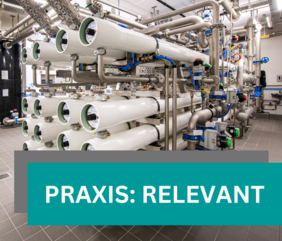Increasing nitrate concentrations in groundwater force water supply companies with the challenge of complying with the nitrate limit value specified in the Drinking Water Guideline. If desirable preventive measures in the catchment area not successful, waterworks are required to implement other solutions. The example of city of Groß-Umstadt in the Federal State of Hessen shows how reverse osmosis can be used as a tailor-made and operationally stable alternative for the removal of nitrate in waterworks.
To provide drinking water from local groundwater sources with high nitrate levels, the city of Groß-Umstadt decided to extend the water treatment technology of their waterworks. In 2017, the city's water supply initiated a collaboration with TZW: DVGW-Technologiezentrum Wasser (German Water Centre) to design a reverse osmosis system for nitrate removal. In Germany, almost 100 reverse osmosis systems for inland desalination are currently in operation in the public water supply - in many cases TZW was involved in the conception and therefore has extensive practical experience.
During design of the reverse osmosis, various load cases were considered to determine the required drinking water flow rate. The possible decommissioning of separate groundwater wells and the drinking water demand for normal and peak delivery were taken into account. As a result, two reverse osmosis lines were planned, each with a drinking water production of 63 m³/h, which can cover varying drinking water demands without long downtimes and ensure redundancy. Reverse osmosis permeate was re-mineralized by mixing with an untreated bypass. The mixing ratio of RO-treated stream and untreated by-pass determines the composition of the drinking water. In this case the ratio was chosen so that a nitrate concentration of approx. 23 mg/L results in the drinking water. This comparatively low concentration was desired by consumers. Naturally, the removal of nitrate also decreases hardness. In the present case, the hardness in drinking water arose to 8.7 °dH (1.6 mmol/L).
The system has been running stably since it was commissioned in 2021. Chemical cleaning of the membranes has not yet been carried out because both pressures and salt retention remain constant. The effort required for operation, including maintenance, averages 16 hours per month. The system is a good example of how advanced technology can be tailored to local requirements in order to efficiently solve even unusual challenges.
The text is an excerpt from an article published in DVGW energie wasser praxis 09/2023. You can read the full article in German here (pdf file).
In the PRAXIS: RELEVANT series, the TZW presents examples of successful projects that have been implemented together with water supply companies.

![[Translate to English:] Prüfstelle-Produktprüfung_Teststand Test centre and product testing](/fileadmin/_processed_/0/9/csm_TZW-Karlsruhe_Pruefung_Geraete-Teststand_377188946c.jpg)
























